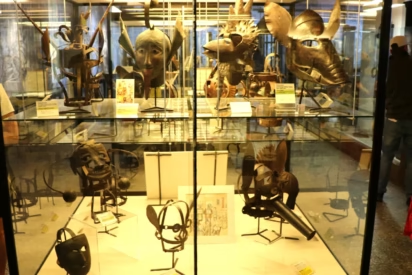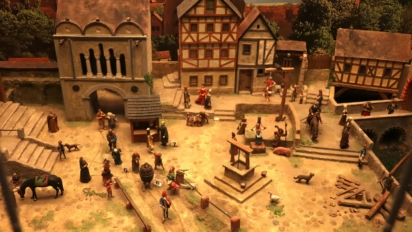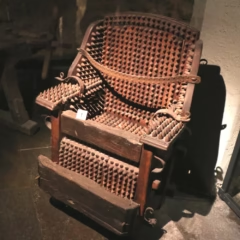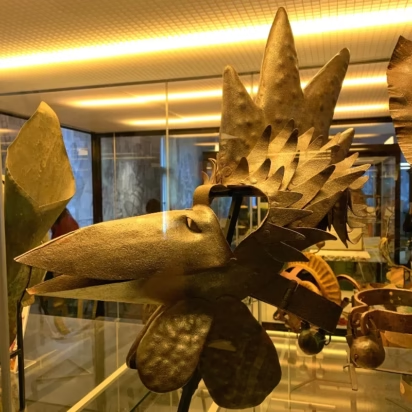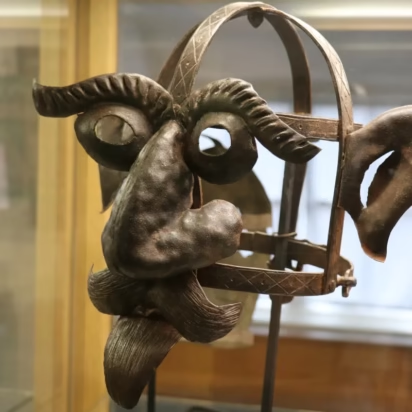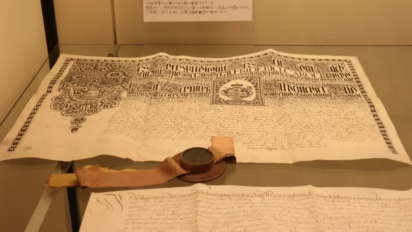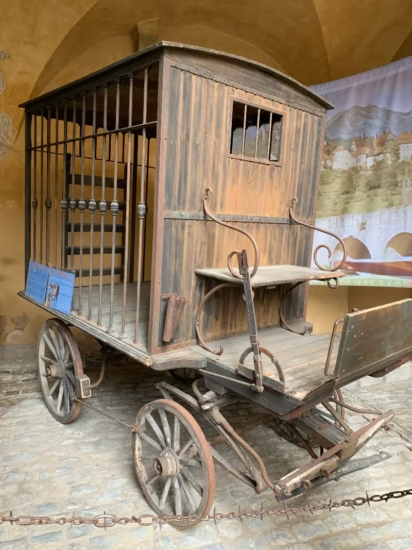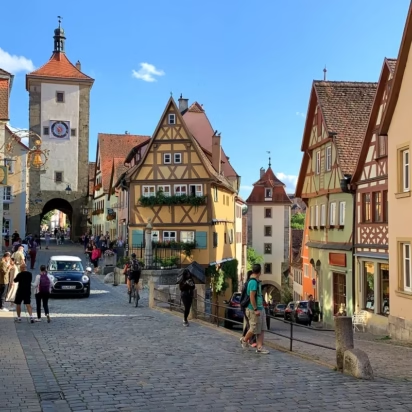The torture instruments and shame masks in the Medieval Crime Museum are among the top sights to see in Rothenburg ob der Tauber on the Romantic Road in Germany.

The Medieval Crime Museum (Mittelalterliches Kriminalmuseum) in Rothenburg ob der Tauber is most famous for its large collection of historic torture devices and public humiliation masks. It is therefore also often known simply as the Torture Museum (Foltermuseum) but in contrast to most torture chambers and dungeons in many European tourist hotspots, this museum is not so much a tourist experience as a serious museum on the development of a thousand years or German and European legal history and the implementation of criminal justice. However, those coming just for the torture implements will see more than enough and, for a change, real historical examples. The “torture museum” is certainly not very romantic but nonetheless one of the top sights to see on the Romantic Road.
Medieval Crime Museum (Torture) in Rothenburg
The Medieval Crime Museum is with over 5,000 items the most important collection of historical criminal justice instruments in Germany. These range from the ever-popular tools of torture to important legal documents and texts.
The collection of the Mittelalterliches Kriminalmuseum is spread over four floors with a further modern venue for temporary exhibitions. Despite the name, it includes a thousand years of European legal history with an emphasis on the German-speaking world. Many items are from the early modern era rather than the Middle Ages (before ca. 1500).
The museum covers the entire criminal justice process from the start of proceedings and the obtaining of evidence to sentencing and punishment. It also has large sections and many exhibitions relating to law in its various forms, including not only criminal law but also constitutional law, family law, the historic role of the church in law, as well as punishment in schools, superstition, and a few spectacular and notorious legal cases.
Exhibitions in the Medieval Crime Museum
The exhibitions in the Medieval Crime Museum are a bit old-fashioned with glass display cases reminding of the 1970s rather than the 21st century. All items are described in English, although once again, here the write-ups are often on laminated cards and not that rigorous.
The museum does have a few media stations but on the whole does not do too much modern interactive displays, which in a collection with many tools of torture is perhaps not that bad a thing. Many of the dioramas are delightfully old-fashioned. It is maybe important to note that very few of the items are actually from Rothenburg itself, and anyway were not used daily or all at the same time. Even during the real Middle Ages, medieval Rothenburg was not one living torture hell and public shaming theater on a daily basis.
The Medieval Crime Museum is very interesting to visit and receives high ratings on Tripadvisor. Some may treat it as a torture museum by simply looking at the tools of torture and public shaming, but visitors can also learn much about the history and development of the criminal justice system in Europe in general and Germany in particular.
Tools of Torture and Public Humiliation in Rothenburg
The museum has a large collection of original instruments of torture and punishment. Many of the torture devices and executioner tools were really used.
Physical torture was not regularly used for punishment but rather to extract confessions, which were usually necessary for guilty verdicts in medieval Europe.
Often, and not entirely surprisingly, just the threat of torture, or tying the accused to the rack, spiky chair, or similar, was sufficient to extract a confession, whether true or not.
Public Humiliation
During much of the Middle Ages and early modern history, prisons played only a minor role in punishment and rehabilitation. Prisons were often used only to hold a suspect before trial or while awaiting execution.
Many crimes, including theft, heresy, and unnatural sex acts, could lead to execution but minor crimes were commonly punished through public humiliation. Criminals were also at times marked with physical burning or a cut in the ear lobe, so anyone would in future be able to easily see it was not someone to be trusted in business dealings.
The Crime Museum has a large collection of items used in public humiliation rituals. The stocks (pillory) were commonly used all over Europe and many survived, or are easily reproduced. (Some are outside the museum for selfies.) Other cities, including Rothenburg, had a special small cage for locking up the punished in a public square for humiliation and to allow mocking, and sometimes to be pelted with food and anything rotten.
Other punishments were more mobile — people had to wear shame masks or iron shoes and were paraded through the market and streets. These items were often fitted with bells to announce the person’s arrival with the bell-ringing sound of the fool.
Neck violins were also commonly used. Both for individuals or for pairs where two argumentative neighbors or couples would be kept in neck violins until settling disputes.
Shame Masks in the Medieval Crime (Torture) Museum in Rothenburg ob der Tauber
The museum has a large collection of masks of shame. These would indicate what the wearer was guilty of, ranging from men behaving as a swine (pig) to being too proud and vain (cockerel). Every mask was filled with symbolism, e.g. long ears (person hears everything), glasses (sees everything), big tongue (gossips), big nose (sticking it in others’ business), snakes or devil (for people with bad thoughts).
The executioner’s mask is a 19th-century invention and the one long on display as such was originally a shame mask. The executioner in any city was just another civil servant known to everybody and thus was unlikely to wear a mask, especially not one with such small eye slits that would make the job more difficult to do.
Some masks were fitted with spikes and screws that could be used for physical punishment when wearing them. In other cases, habitual drunkards, for example, had to wear a heavy barrel that could be weighed down further with additional weights.
Iron Maiden in Rothenburg ob der Tauber
Somewhat ironically, one of the most famous torture devices in the museum, and in a sense most popular too, is a copy of a fake. The Iron Maiden on display is a 19th-century copy of the original Nürnberger Eisernen Jungfrau that was destroyed during the Second World War.
The iron maiden is basically a wooden coat — an artistically more advanced version of the barrel that drunkards could be forced to wear as punishment. The one originally displayed in Nuremberg had a wooden structure originating probably from Bohemia in the 15th century. These were never in common use — only two complete examples survived from the Middle Ages to the modern era.
The Nuremberg example only became an “iron maiden” after it was displayed during the 19th century in Nuremberg in a cabinet of horrors. The owner added spikes — made from French bayonets from the Napoleonic wars — to the inside to horrify the paying public even more. It certainly worked. The Iron Maiden became famous all over the world.
Legal Documents in the Medieval Crime (Torture) Museum in Rothenburg ob der Tauber

A large selection of legal books and documents is on display in the museum. It is probably a good strategy to look at a few in-depth rather than to try and glance at everything just briefly. Some have incredible details in the attached seals and art, while others are of interesting and surprising content.
A few examples:
A Proof of Honest Family was not only a birth certificate but a document confirming that the bearer was a legitimate offspring from an honorable family. Without this document, it would have been impossible to learn a better trade or join a good guild. “Dishonest families” were allowed to do fairly standard honest work, including executioners and grave diggers, but also lower court officials, musicians, and actors. Social classes were often a legal constraint that determined everything from the clothes a person could wear to the number of guests allowed at a wedding.
A Beer Tax agreement on parchment vellum was issued and confirmed through the seals of 44 cities in Brandenburg in 1513. It placed a 12 pfennig tax per tonne of beer, of which 8 went to the margrave and 4 to the city.
Visitor Information: Medieval Crime (Torture) Museum in Rothenburg

The Medieval Crime Museum is open daily:
- April to October — 10:00 – 18:00
- November to March — 13:00 – 16:00
Longer opening hours are likely during advent weekends and the museum is open in the morning only on December 24 and 31.
Admission to the torture museum is €9.50 for adults, €6.50 for students, and €5 for children older than 6. A family ticket for two adults and all own children under 18 is €23.50.
The Mittelalterliches Kriminalmuseum is at Burggasse 3, in the historic old town of Rothenburg just off the main road roughly halfway between the Plönlein and the Marktplatz.
More to See in Town
The top sight in Rothenburg ob der Tauber is undoubtedly its historic old town. Walking on the town walls that still surround the old center is fun and free. The newly reopened Rothenburg Museum focuses on the local history while the High Gothic St. Jakob-Kirche (Church of St James) has with its Tilman Riemenschneider Altar of the Holy Blood (Heilig-Blut-Altar) one of the top artistic highlights of the entire Romantic Road and one of the most important late medieval artworks in Germany.
More on Rothenburg ob der Tauber
For more on the Rothenburg ob der Tauber and nearby sights on the Romantic Road:
- Top Sights on the Romantische Straße with Romantic Road Map
- Walk on the Ramparts and Sentry Walk on the Wall of Rothenburg
- Visit the St.-Jakobs-Kirche (St James Church) with the Tilman Riemenschneider Holy Blood Altar
- Visit the Medieval Crime Museum
- Visit the Wolfgang’s Church in the Klingenbastei
- See the Herrgottskirche with Tilman Riemenschneider Altar of the Virgin in nearby Creglingen
- Transportation to Rothenburg ob der Tauber – Driving or Take the Train
- Bus Day-Trip Tours are often available from Frankfurt or Munich.
- Hotel prices in Rothenburg are surprisingly reasonable, except over weekends.
- Save with the Bayern-Ticket on Train Transportation in Bavaria
- Get online quotations for taxis and airport shuttles from Frankfurt or Munich airports.
